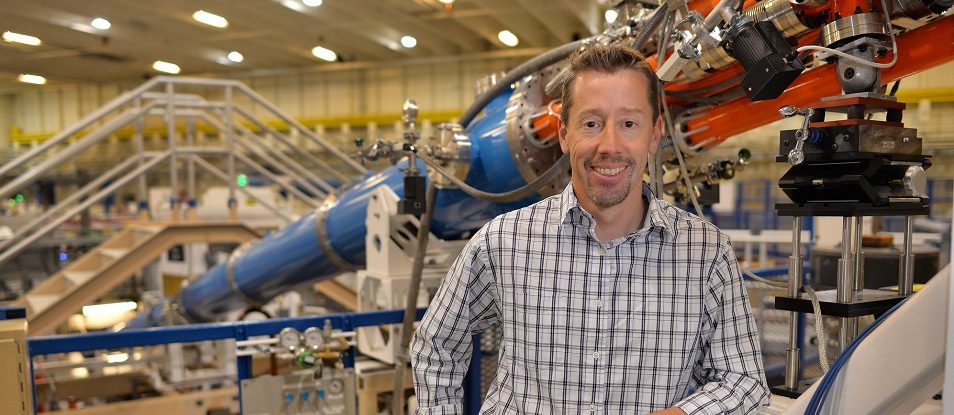
Dynamic Materials
Pushing forward the frontiers of high-energy-density science
Compressing materials under extreme conditions
Sandia scientists are investigating the behavior of a wide-range of materials under the extreme conditions of very high pressures and densities. They seek the answers to such questions as:
- When do insulators become a metal?
- How strong do materials become when they are compressed?
- How and when do materials change their phase at very high pressures?
To answer these questions for materials from Hydrogen to Uranium, we use a complex set of tools, most notably the center’s Z facility, the largest and most sophisticated pulsed power facility in the world. At Z, we can produce a range of conditions in our targets, including reaching pressures up to 40 Million atmospheres. We also operate the Shock Thermodynamic Applied Research (STAR) facility which contains a set of guns, that can fire projectiles at velocities from 100 m/s to 12000 m/s, producing conditions in targets that can reach pressures as high as 10 Million atmospheres. The DICE facility includes a light gas gun and a small pulsed power machine. At each of these facilities, we make the most precise measurements of material conditions of any dynamic materials research lab. We also utilize our state of the art quantum mechanical theoretical models, where we have pioneered the application of these tools to very high pressure materials.
Studying materials at very high pressures using ramp compression
Traditionally, extremely high pressures have been obtained dynamically in the laboratory by controlled impact of one material into another, but this process (called a shock wave) also generates very high temperatures, melting most materials. The electrical current pulse produced by the Z Machine, when sent through a specially shaped short circuit, can create magnetic pressure of millions of atmospheres applied “gently” over a time period up to a millionth of a second. This ramped compression pulse, transmitted from the electrode to a sample material of interest, generates extreme pressures while keeping the temperature relatively low and allowing the sample to remain solid. Velocity measurements at the back side of a sample can be used to deduce the material’s compressibility and sound speed under such conditions.
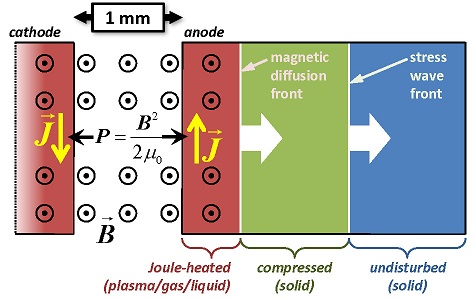
Traditionally, extremely high pressures have been obtained dynamically in the laboratory by controlled impact of one material into another, but this process (called a shock wave) also generates very high temperatures, melting most materials. The electrical current pulse produced by the Z Machine, when sent through a specially shaped short circuit, can create magnetic pressure of millions of atmospheres applied “gently” over a time period up to a millionth of a second. This ramped compression pulse, transmitted from the electrode to a sample material of interest, generates extreme pressures while keeping the temperature relatively low and allowing the sample to remain solid. Velocity measurements at the back side of a sample can be used to deduce the material’s compressibility and sound speed under such conditions.
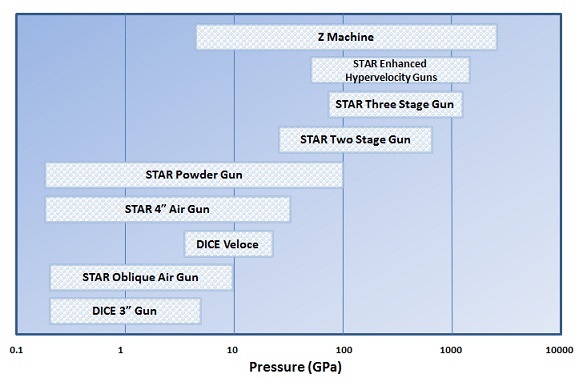
Insulator to metal transition in Hydrogen and why does it matter?
In 1935, physicists Eugene Wigner and Hilliard Huntington predicted that if one could squeeze hydrogen to higher than normal densities, one could change the material from an insulator to a conductor. This transition, known as an insulator-metal transition, should occur at an extreme pressure of several million atmospheres. That prediction was recently observed for the first time in liquid deuterium experiments carried out by Marcus Knudson and others at Sandia’s Z machine and published in the journal, Science. The article is available here. The experiment used the tremendous magnetic fields produced in Z to accelerate a thin aluminum plate that was used to heat and compress liquid deuterium. “When the liquid was compressed to over twelve times its starting density, we say signs that it changed phase from a molecular liquid to an atomic liquid, “ explains Marcus. It was at this point that the liquid became a conductor.
One reason understanding this transition is the importance it may have in understanding our solar system and in particular, the formation of giant gas planets. One issue we presently do not understand is why Saturn is hotter and therefore appears younger than calculations say it should be. An explanation for this behavior in Saturn is that if hydrogen becomes a metal at high pressure, the helium and hydrogen in Saturn’s atmosphere may separate and the helium would rain down toward the surface. This would slow down the rate at which Saturn would cool, thereby leading to higher temperatures than expected. The conditions at which Marcus and his team determined deuterium becomes a metal are consistent with what would be expected to explain the temperature of Saturn.
Strength Experiments
Strength experiments are performed by measuring the ramp loading and unloading behavior of a material of interest. The experimental configuration is shown on the image to the right.
The current pulse produces a ramp compression wave that passes from the electrode into the sample material and then into a lithium fluoride window. The velocity at the sample/LiF window is measured with laser interferometry.
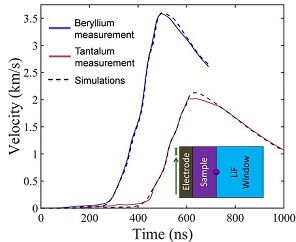
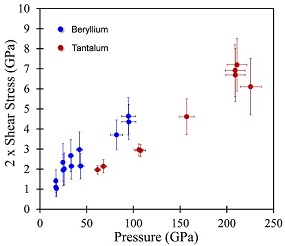
Examples of measurements in beryllium and tantalum at peak pressures of 100 GPa are shown along with simulations conducted without a strength model; the differences illustrate the qualitative effect of strength. An analytic technique can be used to infer an effective shear stress near the peak pressure1, the results of which are shown below2,3:
Citations:
J.L. Brown, C.S. Alexander, J.R. Asay, T.J. Vogler and J.L. Ding, J. Appl. Phys. 114 (2), 223518 (2013). 2. J.L. Brown, C.S. Alexander, J.R. Asay, T.J. Vogler, D.H. Dolan and J.L. Belof, J. Appl. Phys. 115 (4), 043530 (2014). 3. J.L. Brown, M.D. Knudson, C.S. Alexander and J.R. Asay, J. Appl. Phys. 116, 033502 (2014).